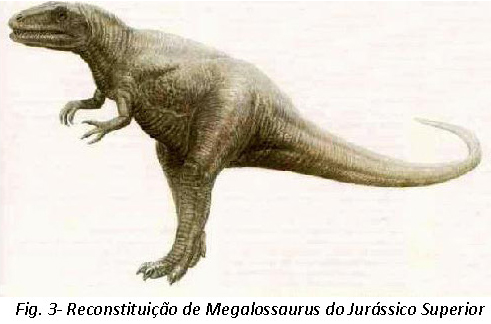As
pegadas de dinossáurio carnívoro
do Cabo Mondego
O Cabo Mondego é um verdadeiro livro da História Geológica do
período Jurássico, entre os 185 e os 120 M. A. (milhões de anos). A
Rota do Jurássico é um conjunto de earthcaches que
lhe vão dar oportunidade de “viver” nos tempos em que
os Megalossáurios calcorreavam este litoral, de ver diversos
paleoambientes, perceber as regressões e transgressões marinhas
desta zona, apreciar as formações sedimentológicas, observar muitos
registos fósseis, enfim sentir um verdadeiro tesouro
super-antiquíssimo. Um tesouro único que temos à nossa disposição e
que é de todos nós. Tome atenção especial à sua preservação –
se quiser levar alguma recordação para casa (rochas, fósseis, etc.)
leve-a na máquina fotográfica/GPS ou telemóvel.
E se trouxer algum saco de plástico faça um CITO (cache in trash
out)!
O estudo das pegadas de
dinossáurio da jazida do cabo Mondego transporta-nos até um mundo
muito diferente do actual, há cerca de 150 milhões de
anos.
Estes icnitos fornecem-nos
preciosas informações paleoecológicas, paleobiológicas,
paleogeográficas, sedimentológicas e estratigráficas, permitindo
inferir muitas das características do comportamento dos
dinossáurios e do seu habitat.
O primeiro trabalho publicado
em Portugal acerca de jazidas de pegadas de dinossáurios foi
justamente sobre a jazida do Cabo Mondego.
O seu autor é Jacinto Pedro
Gomes, naturalista do Museu Nacional de História Natural e a
publicação data de 1921, tendo a jazida sido descoberta muito
antes, em 1884. Jacinto Pedro Gomes removeu parte dessas pegadas
levando-as para o referido museu, onde até hoje se encontram em
exposição.
…/…
A jazida do cabo Mondego é
riquíssima. Contém diversos níveis com pegadas de dinossáurios
carnívoros e uma subimpressão (impressão nas camadas subjacentes à
superfície das pegadas). Ocorrem todas registadas em calcários
apresentando-se frequentemente preenchidas por areias. Algumas das
pegadas têm a impressão do dedo em “V”, indicando
tratar-se de um dinossáurio muito primitivo, uma vez que o
encurtamento deste dedo é uma característica evolutiva. Muitas
terminam em ponta, devido às fortes e pontiagudas garras no final
de cada dedo do animal. Quase todas apresentam a marca da planta do
pé do dinossáurio, sendo plantígradas. Este facto não é muito
vulgar em icnitos de carnívoros, já que estes apoiavam apenas os
dedos no sedimento, indicando por isso, ou que o sedimento seria
muito brando, ou que estaria ao ataque, à defesa ou em actividades
de exibição perante outros dinossáurios.
Carla Alexandre
Tomás
Jornadas
Litoral’03, Figueira da Foz

Os dinossáurios
do Jurássico Superior que deixaram pegadas no Cabo Mondego eram
Terópodes (dinossáurios com bacia de réptil) dos géneros
Eutynichniuni
e Megalosauripus - Gomes 1915/16;
ATENÇÃO À MARÉ!
Para aceder ao local da pegada deve escolher uma
hora de maré-baixa.
Como
reclamar o found:
Na pegada indicada
pelas coordenadas faça a medição da sua maior
profundidade em relação aos bordos.
Envie
essa medida para o meu mail para que lhe seja autorizado o log
desta earthcache.
The footprints of carnivorous dinosaurs of the Cabo Mondego
The Cabo
Mondego is
a true
book of
Geological History of
the Jurassic period, between
185 and
120 M.
A. (million
years). “Route of Jurassic”
is a set of earthcaches that
will give you
the opportunity to "live" in the days when the Megalosaurs walk over
this coast,
to see different
paleoenvironments, understand the marine
transgressions and regressions in this
area, examine the sediment formations,
observe many
records fossils,
and finally to feel a super-ancient treasure. A unique treasure that
we have at our
disposal and that
is all of us.
Take special
care to preserve the
environment - if you want to take
home some
souvenir (rocks, fossils,
etc.). Take it
to the
camera /
GPS or mobile
phone.
Andif
you bring a
plastic bag, make
a CITO
(cache in
trash out)!
The study of dinosaur footprints in the quarry of Cabo
Mondego transports us to a world very different from today, from
about 150 million years ago.
These footprints should provide us with valuable
information paleoecological, paleobiological, palaeogeographic,
sedimentological and stratigraphic, allowing us to infer many
features of the behaviour of dinosaurs and their
habitat.
The first work, published in Portugal, about deposits of
dinosaur footprints on the field was precisely about the ones of
Cabo Mondego.
The author is Jacinto Pedro Gomes, a naturalist at the
National Museum of Natural History and the publication dates from
1921. The deposit was discovered much earlier, in 1884. Jacinto
Pedro Gomes removed some of these footprints leading them to that
museum, where they are today on display (fig.1 and 2).
…/…
The deposit at Cabo Mondego is very rich. It contains
several levels with footprints of carnivorous dinosaurs. They all
occur recorded in limestone, often filled with sand. Some of the
footprints have the impression of a "V" finger indicating that this
was a very primitive dinosaur, since the shortening of the finger
is an evolutionary trait. Many end in a point, due to strong and
sharp claws at the end of each finger of the animal. Almost all of
them have the mark of the foot of the dinosaur, and are
plantigrades. This is not very common in carnivore footprints,
since they supported only the fingers in the sediment, thus
indicating that the sediment was too soft or that the dinosaur
would have been in attack or defence position or involved in other
exhibition activities to other dinosaurs.
Carla Alexandre
Tomás
Jornadas
Litoral’03, Figueira da Foz
The Upper Jurassic dinosaurs which left footprints in Cabo
Mondego were Theropods (dinosaurs with reptile pelvis) of the genus
Eutynichniuni eMegalosauripus -
Gomes 1915/16; (fig.3)
ATTENTION TO THE TIDE!
To access the site's footprint you should choose a period
of low tide.
How to claim your
found:
In the footprint indicated by the
given coordinates, please make the measurement of its
greater depth in relation to the edges.
Send the answer to my e-mail so that
I can allow you to log this earthcache.